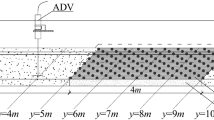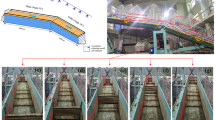Abstract
To quantify the impacts of native vegetation on the spatial and temporal variations in hydraulic properties of bank gully concentrated flows, a series of in situ flume experiments in the bank gully were performed at the Yuanmou Gully Erosion and Collapse Experimental Station in the dry-hot valley region of the Jinsha River, Southwest China. This experiment involved upstream catchment areas with one- and two-year native grass (Heteropogon contortus) and bare land drained to bare gully headcuts, i.e., Gullies 1, 2 and 3. In Gully 4, Heteropogon contortus and Agave sisalana were planted in the upstream catchment area and gully bed, respectively. Among these experiments, the sediment concentration in runoff in Gully 3 was the highest and that in Gully 2 was the lowest, clearly indicating that the sediment concentration in runoff obviously decreased and the deposition of sediment obviously increased as the vegetation cover increased. The concentrated flows were turbulent in response to the flow discharge. The concentrated flows in the gully zones with native grass and bare land were sub- and supercritical, respectively. The flow rate and shear stress in Gully 3 upstream catchment area were highest among the four upstream catchment areas, while the flow rate and shear stress in the gully bed of Gully 4 were lowest among the four gully beds, indicating that native grass notably decreased the bank gully flow rate and shear stress. The Darcy-Weisbach friction factor (resistance f) and flow energy consumption in the gully bed of Gully 4 were notably higher than those in the other three gully beds, clearly indicating that native grass increased the bank gully surface resistance and flow energy consumption. The Reynolds number (Re), flow rate, shear stress, resistance f, and flow energy consumption in the gully beds and upstream areas increased over time, while the sediment concentration in runoff and Froude number (Fr) decreased. Overall, increasing vegetation cover in upstream catchment areas and downstream gully beds of the bank gully is essential for gully erosion mitigation.
Similar content being viewed by others
References
Bastola S, Dialynas YG, Bras RL, et al. (2018) The role of vegetation on gully erosion stabilization at a severely degraded landscape: A case study from Calhoun Experimental Critical Zone Observatory. Geomorphology 308: 25–39. https://doi.org/10.1016/j.geomorph.2017.12.032
Bennett SJ, Casali J (2001) Effect of initial step height on headcut development in upland concentrated flows. Water Resour Res 37: 1475–1484. https://doi.org/10.1029/2000WR900373
Bennett SJ, Casali J, Robinson KM, et al. (2000) Characteristics of actively eroding ephemeral gullies in an experimental channel. T ASAE 43: 641–649. https://doi.org/10.13031/2013.2745
Chen A, Zhang D, Peng H, et al. (2013) Experimental study on the development of collapse of overhanging layers of gully in Yuanmou Valley, China. Catena 109: 177–185.
De Baets S, Poesen J, Meersmans J, et al. (2011) Cover crops and their erosion-reducing effects during concentrated flow erosion. Catena 85: 237–244. https://doi.org/10.1016/j.catena.2011.01.009
Dong YF, Xiong DH, Su ZA, et al. (2014) The distribution of and factors influencing the vegetation in a gully in the Dry-hot Valley of southwest China. Catena 116: 60–67. https://doi.org/10.1016/j.catena.2013.12.009
Dong YF, Xiong DH, Su ZA, et al. (2013) Critical topographic threshold of gully erosion in Yuanmou Dry-hot Valley in Southwestern China. Phys Geogr 34: 50–59. https://doi.org/10.1080/02723646.2013.778691
Dong YF, Xiong DH, Su ZA, et al. (2018) Effects of vegetation buffer strips on concentrated flow hydraulics and gully bed erosion based on in situ scouring experiments. Land Degrad Dev 29: 1672–1682. https://doi.org/10.1002/ldr.2943
Dong YF, Xiong DH, Su ZA, et al. (2019) The influences of mass failure on the erosion and hydraulic processes of gully headcuts based on an in situ scouring experiment in Dry-hot valley of China. Catena 176: 14–25. https://doi.org/10.1016/j.catena.2019.01.004
FAO (2015) World reference base for soil resources 2014. International soil classification system for naming soils and creating legends for soil maps. World Soil Resources Report 106, Rome.
Fu B, Liu Y, Lü Y, et al. (2011) Assessing the soil erosion control service of ecosystems change in the Loess Plateau of China. Ecol Complexity 8: 284–293. https://doi.org/10.1016/j.ecocom.2011.07.003
Gómez Gutiérrez Á, Schnabel S, Felicísimo ÁM (2009) Modelling the occurrence of gullies in rangelands of southwest Spain. Earth Surf Proc Land 34: 1894–1902. https://doi.org/10.1002/esp.1881
Gong JG, Jia YW, Zhou ZH, et al. (2011) An experimental study on dynamic processes of ephemeral gully erosion in loess landscapes. Geomorphology 125: 203–213. https://doi.org/10.1016/j.geomorph.2010.09.016
Gudino-Elizondo N, Biggs TW, Castillo C, et al. (2018) Measuring ephemeral gully erosion rates and topographical thresholds in an urban watershed using unmanned aerial systems and structure from motion photogrammetric techniques. Land Degrad Dev 29: 1896–1905. https://doi.org/10.1002/ldr.2976
Hancock GR, Evans KG (2006) Gully position, characteristics and geomorphic thresholds in an undisturbed catchment in Northern Australia. Hydrol Process 20: 2935–2951. https://doi.org/10.1002/hyp.6085
Hancock GR, Evans KG (2010) Gully, channel and hillslope erosion — an assessment for a traditionally managed catchment. Earth Surf Proc Land 35: 1468–1479. https://doi.org/10.1002/esp.2043
Horton RE (1945) Erosional development of streams and their drainage basins: hydrophysical approach to quantitative morphology. Bulletin of the Geological Society of America 56: 275–370. https://doi.org/10.1130/0016-7606(1945)56[275:EDOSAT]2.0.CO;2
Kirkby MJ, Bull LJ, Poesen J, et al. (2003) Observed and modelled distributions of channel and gully heads — with examples from SE Spain and Belgium. Catena 50: 415–434. https://doi.org/10.1016/S0341-8162(02)00128-5
Marzolff I, Ries JB, Poesen J (2011) Short-term versus medium-term monitoring for detecting gully erosion variability in a Mediterranean environment. Earth Surf Proc Land 36: 1604–1623. https://doi.org/10.1002/esp.2172
Nyssen J, Veyret-Picot M, Poesen J, et al. (2004) The effectiveness of loose rock check dams for gully control in Tigray, northern Ethiopia. Soil Use Manage 20: 55–64. https://doi.org/10.1111/j.1475-2743.2004.tb00337.x
Pederso, JL, Petersen PA, Dierker JL (2006) Gullying and erosion control at archaeological sites in Grand Canyon, Arizona. Earth Surf Proc Land 31: 507–525. https://doi.org/10.1002/esp.1286
Poesen J, Nachtergaele J, Verstraeten G, et al. (2003) Gully erosion and environmental change:importance and research needs. Catena 50: 91–133. https://doi.org/10.1016/S0341-8162(02)00143-1
Shellberg JG, Spencer J, Brooks AP, et al. (2016) Degradation of the Mitchell River fluvial megafan by alluvial gully erosion increased by post-European land use change, Queensland, Australia. Geomorphology 266: 105–120. https://doi.org/10.1016/j.geomorph.2016.04.021
Sidorchuk A (1999) Dynamic and static models of gully erosion. Catena 37: 401–414. https://doi.org/10.1016/S0341-8162(99)00029-6
Sidorchuk A (2006) Stages in gully evolution and self-organized criticality. Earth Surf Proc Land 31: 1329–1344. https://doi.org/10.1002/esp.1334
Su ZA, Xiong DH, Zhang JH, et al. (2019) Variation in the vertical zonality of erodibility and critical shear stress of rill erosion in China’s Hengduan Mountains. Earth Surf Proc Land 44: 88–97. https://doi.org/10.1002/esp.4482
Su ZA, Xiong DH, Dong YF, et al. (2014) Simulated headward erosion of bank gullies in the Dry-hot Valley Region of southwest China. Geomorphology 204: 532–541. https://doi.org/10.1016/j.geomorph.2013.08.033
Su ZA, Xiong DH, Dong YF, et al. (2015a) Hydraulic properties of concentrated flow for a bank gully in the Dry-hot Valley Region of southwest China. Earth Surf Proc Land 40: 1351–1363. https://doi.org/10.1002/esp.3724
Su ZA, Xiong DH, Dong YF, et al. (2015b) Influence of bare soil and cultivated land use types upstream of a bank gully on soil erosion rates and energy consumption for different gully erosion zones in the dry-hot valley region, Southwest China. Nat Hazards 79: S183–S202. https://doi.org/10.1007/s11069-015-1722-x
Tebebu TY, Abiy AZ, Zegeye AD, et al. (2010) Surface and subsurface flow effect on permanent gully formation and upland erosion near Lake Tana in the northern highlands of Ethiopia. Hydrol Earth Syst Sc 14: 2207–2217. https://doi.org/10.5194/hess-14-2207-2010
Valentin C, Poesen J, Li Y (2005) Gully erosion: Impacts, factors and control. Catena 63: 132–153. https://doi.org/10.1016/j.catena.2005.06.001
Vandekerckhove L, Poesen J, Wijdenes DO, et al. (1998) Topographical thresholds for ephemeral gully initiation in intensively cultivated areas of the Mediterranean. Catena 33: 271–292. https://doi.org/10.1016/S0341-8162(98)00068-X
Wells RR, Alonso CV, Bennett SJ (2009) Morphodynamics of headcut development and soil erosion in upland concentrated flows. Soil Sci Soc Am J 73: 521–530. https://doi.org/10.2136/sssaj2008.0007
Wells RR, Bennett SJ, Alonso CV (2010) Modulation of headcut soil erosion in rills due to upstream sediment loads. Water Resour Res 46. https://doi.org/10.1029/2010WR009433
Wells RR, Momm HG, Bennett SJ, et al. (2016) A Measurement Method for Rill and Ephemeral Gully Erosion Assessments. Soil Sci Soc Am J 80: 203–214. https://doi.org/10.2136/sssaj2015.09.0320
Wilkinson SN, Hancock GJ, Rebecca B, et al. (2013) Using sediment tracing to assess processes and spatial patterns of erosion in grazed rangelands, Burdekin River basin, Australia. Agric Ecosyst Environ 180: 90–102. https://doi.org/10.1016/j.agee.2012.02.002
Wilson G (2011) Understanding soil-pipe flow and its role in ephemeral gully erosion. Hydrol Process 25: 2354–2364. https://doi.org/10.1002/hyp.7998
Xiong DH, Yan D, Long Y, et al. (2010) Simulation of morphological development of soil cracks in Yuanmou Dry-hot Valley Region, Southwest China. Chinese Geogr Sci 20: 112–122.
Yang D, Xiong DH, Guo M, et al. (2014) Impact of grass belt position on the hydraulic properties of runoff in gully beds in the Yuanmou Dry-hot Valley Region of Southwest China. Phys Geogr 36: 408–425. https://doi.org/10.1080/02723646.2015.1074517
Yang D, Xiong DH, Guo M, et al. (2015) Impact of grass belt position on the hydraulic properties of runoff in gully beds in the Yuanmou Dry-hot valley region of Southwest China. Phys Geogr 36: 408–425.
Zabihi M, Mirchooli F, Motevalli A, et al. (2018) Spatial modelling of gully erosion in Mazandaran Province, northern Iran. Catena 161: 1–13. https://doi.org/10.1016/j.catena.2017.10.010
Zakerinejad R, Maerker M (2015) An integrated assessment of soil erosion dynamics with special emphasis on gully erosion in the Mazayjan basin, southwestern Iran. Nat Hazards 791: S25–S50. https://doi.org/10.1007/s11069-015-1700-3
Zegeye AD, Langendoen EJ, Tilahun SA, et al. (2018) Root reinforcement to soils provided by common Ethiopian highland plants for gully erosion control. Ecohydrology 11: UNSP e1940. https://doi.org/10.1002/eco.1940
Zhang BJ, Xiong DH, Zhang GH, et al. (2018) Impacts of headcut height on flow energy, sediment yield and surface landform during bank gully erosion processes in the Yuanmou Dry-hot Valley region, southwest China. Earth Surf Proc Land 43: 2271–2282. https://doi.org/10.1002/esp.4388
Zhu TX (2012) Gully and tunnel erosion in the hilly Loess Plateau region, China. Geomorphology 153: 144–155. https://doi.org/10.1016/j.geomorph.2012.02.019
Acknowledgements
This work was supported by the National Key Research and Development Program of China (2017YFC0505102), the Second Tibetan Plateau Scientific Expedition and Research Program (STEP, No. 2019QZKK0307), and the Major Science and Technology Program for Water Pollution Control and Treatment (2017ZX07101-001).
Author information
Authors and Affiliations
Corresponding author
Electronic Supplementary Material
Rights and permissions
About this article
Cite this article
Su, Za., He, Zy., Zhou, T. et al. Impacts of native vegetation on the hydraulic properties of the concentrated flows in bank gullies. J. Mt. Sci. 18, 907–922 (2021). https://doi.org/10.1007/s11629-020-6287-9
Received:
Revised:
Accepted:
Published:
Issue Date:
DOI: https://doi.org/10.1007/s11629-020-6287-9




